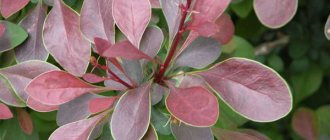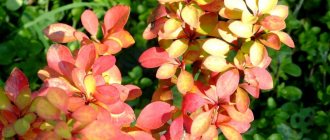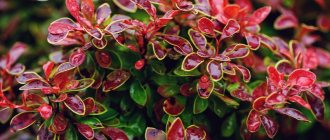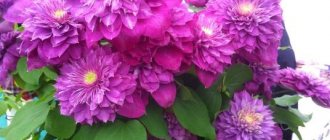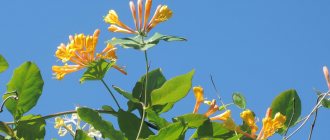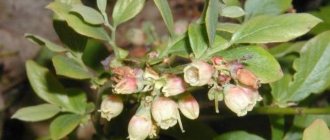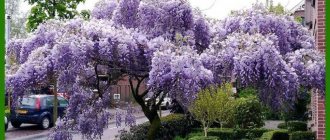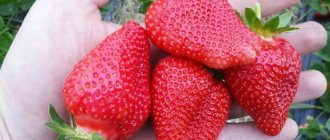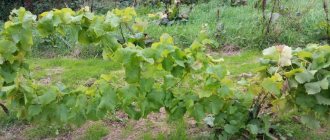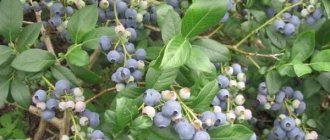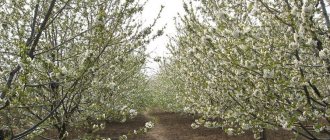Barberry Koronita - decoration and protection of the garden
You can use shrubs on your site in various variations and compositions. This plant involuntarily attracts the eye with its unusually bright attire. The density of foliage and thorns will become an impassable barrier in a few years. Therefore, placing seedlings along the fence will provide natural protection for the area from winds and unwanted guests. It is necessary to plant plants lengthwise along the fence in close proximity to each other. The originality of barberry is also manifested in its plasticity.
By pruning and forming a bush, you can create attractive compositions that will decorate the area
Preparing for winter
Coronita has high frost resistance, so it can easily winter without shelter at temperatures not lower than -30 ° C. However, if strong winds blow in the region, then it is worth preparing protection for the bush. Before the onset of cold weather, a layer of mulch at least 10 cm thick is placed around the bush.
Shelter for the winter
It is recommended to cover young plants with any fabric material.
Description of barberry
Barberry Thunberg is a magnificent deciduous shrub. Champion of the genus among ornamental species. When describing Barberry thunberg, only superlative words come to mind. He delights and pleases the eye with his special appearance. With its ever-fresh, bright foliage and fragrant flowers. This smell also attracts bees. Blooming, it is a wonderful honey plant.
Young shoots grow densely and are covered with many thorns. They are thin and elastic, 1 cm long. The height of the plant varies from 0.50 cm to 1.50 meters. The roots are located close to the surface of the earth. The leaves are oval, pointed and smooth - from 2.5 to 3 cm in length.
Barberry coronita begins to bloom in May. Graceful, bright flowers are arranged singly or in clusters. The crown of the flowers is light orange. Flowering duration is about 14 days. The berries that appear ripen by October. They are oblong in appearance and red in color. Unfortunately, these berries are inedible due to their bitter taste. In winter it is an excellent food for birds.
Coronita berries delight everyone with their brightness until winter
Features of culture
Barberry Thunberg Aurea
Barberry Koronita is a medium-sized ornamental shrub that has arched branches. The height of the bush does not exceed 0.5-1 m. The shape of the plant is quite spreading, cushion-shaped. The bush can reach up to 1.5 m in width. The root system is superficial, it is important to be very careful when weeding, removing weeds and loosening the root zone. During the season, the growth of the bush averages about 10 cm.
In total, Coronita stands out among other varieties with its original appearance. The peculiarity of this variety is that the bright beautiful leaves sometimes change color to a bright purple color in autumn. Even the thorns of the bushes are very bright and immediately attract attention. They are quite large in size, pink in color, with a creamy tint, juicy and attractive.
Barberry Thunberg Koronita
Another feature of the variety, which is successfully used by most gardeners and landscape designers, is that the plantings can be given any shape and appearance by cutting the branches. The inflorescences, located densely along the entire length of the branches, have a bright yellow color. In the harsh climatic conditions of the Russian climate, the plant adapts perfectly and grows well without much difficulty, and feels great in both hot and cool weather.
Koronita barberry blooms towards the end of spring, and in autumn the bushes are decorated with beautiful bright red fruits. But you shouldn’t eat them, as they are not only inedible, but also poisonous. When eating the fruits, serious digestive disorders and poisoning can occur. The only purpose of the fruit is to additionally decorate the bushes.
Features of use
A description of the barberry variety Koronita will not be complete without indicating the scope of use of the plant. As has already become clear, it is impossible to use the fruits as food, so the plant is used exclusively for decorative purposes. In landscape design, the use of barberry bushes is multifaceted.
Used for decorative purposes only
Many people use such plantings as hedges and borders. The bushes are easy to trim and can be changed in shape. In our country it is not possible to use boxwood shrubs for decorative purposes; barberry bushes of this variety will be an ideal alternative. They give the gardener the opportunity to realize any fantasies. Since the growth of Thunberg Coronita barberry bushes is small, the hedges will not be too high, but if trimmed correctly they will be very beautiful.
Often such bushes are used to create rock gardens and beautiful compositions in the garden.
Choosing a seedling and place for planting
Barberry Thunberg Coronite does not require special conditions and does not create any trouble. It is undemanding to soil types. It grows on loose sandy loams and loams, on poor and fertile soil. The shrub is able to grow in soils with any acidity, but still prefers neutral.
If you are forced to plant a plant in a place with acidic soil, you must choose one of the liming options:
- 300-400 g slaked lime.
- 200 g wood ash.
Drought is not dangerous for plant growth and development. But he does not like wetlands and stagnant water. After rain or snowmelt, drainage is required. The shrub has only one requirement - its desired location. It is better to plant Thunberg in places where there is a lot of sun or light partial shade.
Shading will affect the color of the leaf. His outfit will be more modest than that of his brothers on the sunny side.
Gardeners recommend purchasing Thunberg seedlings from nurseries. There they are cultivated in containers. The survival rate will be higher provided that the nursery is located in the same area. The plants, while developing, have already acclimatized and become stronger. It is possible to remove the seedling from the container without harm by first lowering it into a container of water. Once saturated, the soil will be more pliable and the root system will not be damaged.
Where to buy seedlings
It is recommended to buy seedlings in a special nursery, where you can get a detailed description of the correct planting, care and propagation of the plant from experienced employees. They will also tell you how to prune coronita barberry correctly and how to use it to create chic compositions. It is recommended to ask nursery employees to provide documentation confirming the quality of the products. When purchasing a plant from a nursery, you can rest assured that you are purchasing an absolutely healthy plant, unlike amateur gardeners who sell seedlings secondhand. Coronite is a real work of art created by nature, and anyone can decorate their garden or personal plot with it. This variety will appeal to fans of unusual and original plants.
Article Rating
Landing according to the rules
Coronita is not a capricious plant. However, in order for a healthy and full-fledged bush to grow, it is necessary to follow all planting rules and provide full care. It is possible to start planting young bushes in open ground in the spring, when the spring frosts have ended. The depth of the planting hole and its diameter should be about 50 cm.
A drainage layer of sand and gravel is laid at the bottom. The roots need to be checked - cleaned of soil, damaged and rotten ones removed. When planting bushes in groups, maintain a distance of 1.6 to 2 m. This is the optimal distance for the growth and development of the bush. When planting a hedge, prepare holes with a span of about 50 cm.
A drainage layer and a substrate - consisting of humus, sand and earth - are placed at the bottom of the pit.
Landing sequence:
- The seedling is removed from the pot with maximum care.
- Place it in a hole so that the root collar is covered with 4-5 cm of soil.
- The substrate is placed on the roots and compacted.
- Moisten the soil well and cover it with hay or grass.
- The stems are trimmed, leaving 3 buds above the ground.
It is recommended to water the seedlings at intervals of 7-10 days.
How to properly care
Depending on the weather conditions and the quality of the soil in which your barberry grows, you need to draw up a schedule of basic care activities.
Fertilizer and watering
- Barberry has enough rainfall to moisturize. But, on especially hot and dry days, additionally moisten the soil. To ensure that all the water is completely absorbed, make a 10 cm high roller around the perimeter of the circle around the trunk.
- Water at the roots. Use soft and warm water. After moistening, do not forget to loosen the soil and get rid of weeds so that the bush receives the right amount of oxygen and the weeds do not take away nutrients.
- Mulching the soil with dry leaves and sawdust around the bush will help retain moisture for a longer period. In autumn, it is advisable to mulch with peat or dry compost.
- It is better to choose organic fertilizers: humus and compost. They should be added in the spring, when the soil is dug up. The rest of the time you don’t need to fertilize with anything. It all depends on the condition of the soil in a particular area.
Trimming
Conducted after winter. It is necessary to remove all frozen branches. To do this, wait until the leaves begin to appear to see the whole picture. Once every 2 years it is necessary to carry out formative and sanitary pruning. All dry and weak branches are removed, and those that grow inside the crown are also eliminated.
Pests
Although barberry is considered a plant resistant to attacks by harmful insects, some measures should still be taken.
- Barberry aphid. On the bush, the leaves begin to change shape, become deformed and dry out. Treatment should begin quickly, in the spring. The following solution will help: take 300 grams of laundry soap per 10 liters of water. You can add another 500 grams of shag. Spray the bush.
- Flower moth. These pests eat the fruit. Use a solution of chlorophos (0.1 - 0.3%) or decis (0.05 - 0.1%).
- Powdery mildew. Rarely gets sick. A characteristic whitish coating appears on both sides of the leaf, on the berries and branches. In the autumn months, black bodies appear in which the fungus remains until spring. The infection is treated with colloidal sulfur (0.5%) or sulfur-lime decoction. Carry out the treatment once every 14 - 20 days. Severely affected parts are removed and burned.
In what season should I prune?
The small size of the bush allows it to be given formative pruning infrequently.
Once you have chosen a decorative form, it is advisable to simply maintain it. The ideal time for this is spring, when there is no sap flow yet. Sanitary pruning is done when the buds open. Frostbitten, old or poorly developed branches are removed. Pruning in the summer (June, August) is also possible. Basically, this measure is used to form a hedge.
Pruning is beneficial for barberry. The color of the foliage becomes even more expressive, the crown is thicker and, accordingly, the bushes are more interesting.
Barberry Thunberg Red Chief
Tall, reaching a height of two meters, the decorative variety Red Chief barberry forms a wide spreading bush with dark red shoots and the same lanceolate foliage narrowed to the petiole. Flowering begins in the last days of May or June, when yellow flowers collected in groups of 3–7 pieces open on the bushes. The oblong pink or red fruits ripen by September and remain on the branches even under the snow.
With its high decorative value, the Thunberg Red Chief barberry in the middle zone can seriously freeze in winter, so it is better to cover young plants weakened by transplantation in the fall.
Reproduction
Barberry bushes of the Koronita variety are propagated in several ways: layering, shoots, cuttings, seeds and dividing the bush.
Overgrowth
Every year, young shoots grow from the root system. In early spring or autumn, it is possible to dig up the mother bush for its subsequent division. The bush is divided so that each part has a strong root system and several young shoots. For better survival, parts of the bush are immediately planted in a prepared hole;
By layering
When propagating barberry by layering - in the spring, lower branches are dug in and secured with staples. Receiving constant watering, the cuttings will produce the first shoots in 2-3 weeks. More rapid development of the root system will occur with regular soil moistening, loosening and mulching. It is possible to separate the shoots in the fall or next spring;
Cuttings
Propagation of barberry by cuttings is possible in 2 ways:
- Cut the woody branches into 15 cm pieces.
- Green shoots are cut at an angle of 45.
The lower part of the prepared material is pollinated with a root formation stimulator and planted in the prepared container. Cover the top with a plastic transparent container or bottle to maintain the required humidity. The results of cuttings are noticeable within a month.
Established specimens are assigned to a permanent place in the spring or autumn
Seeds
The most time-consuming and thankless work is planting the seeds of barberry thunberg. Their germination rate is only 16-45%. The stratification process is long - about 3 months in the refrigerator. The opportunity to identify a plant in a permanent place arises only after 2-3 years.
Barberry Thunberg Golden Rocket
This is a bright variety with a one and a half meter pyramidal crown and rich yellow-green foliage. The five-year-old Thunberg Golden Rocket barberry bush does not exceed 70 cm in height, the width of the compact crown is half that. Small yellow flowers appear at the beginning of summer, and the few fruits in the middle zone acquire a scarlet color at the end of summer or in September.
In many regions of Russia, during frosts, one-year-old shoots of the Thunberg Golden Rocket barberry may suffer, which, without shelter, freeze to the level of snow cover. But even in such a situation, the decorative quality of the plant is soon restored. And to prevent the dense crown from breaking during wintering, it is better to tie it or strengthen it with a net in the fall.
Pests and diseases
Having good immunity to various diseases, thunberg barberry still needs human help. When a viral infection spreads, the plant may become damaged. Powdery mildew, rust, drying of shoots, leaf spotting are the most common fungal infections. To combat them, various fungicides are used to spray plants.
Pests that eat leaves, such as moths, sawflies or aphids, are treated with Fitoverm.
Barberry Thunberg is a versatile plant. It can be used in landscape design - decorating landscape compositions and ceremonial places.
Gardeners fell in love with this shrub for its unpretentiousness, decorativeness and rapid growth. They appreciated all its characteristics and successfully use it to create bright and picturesque compositions.
Barberry in landscape design
This variety of barberry is used in row plantings and the construction of borders in personal plots. It should be used only in the foreground of the garden composition. Because this unusual plant absolutely cannot be hidden, and it will decorate any landscape design. It can be chosen as an accent in a woody floral arrangement and retains its attractive appearance all year round. The high decorative properties of barberry will make it the main decoration of any garden. It will delight with delicate greens in the spring, rich green hues in the summer and purple in the fall. It is used both to create group compositions from different plants, and individually for the construction of hedges and borders of different heights. Coronita is also used for single plantings. Due to the fact that the shrub can be trimmed, landscape design specialists can easily give it an original, intricate shape.
Barberry Koronita will be an ideal solution for decorating a small garden plot. Combining shrubs with other plants will create original and contrasting plantings. Barberry looks good in combination with the lush greenery of coniferous plants. It blends harmoniously with other flowering plants and does not get lost against their background. Its unpretentiousness in planting and care allows barberry to be used by both beginning amateur gardeners to decorate their garden plots and by experienced landscape designers in their work.
